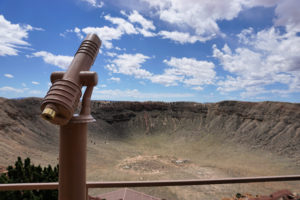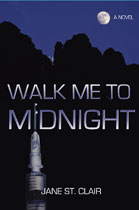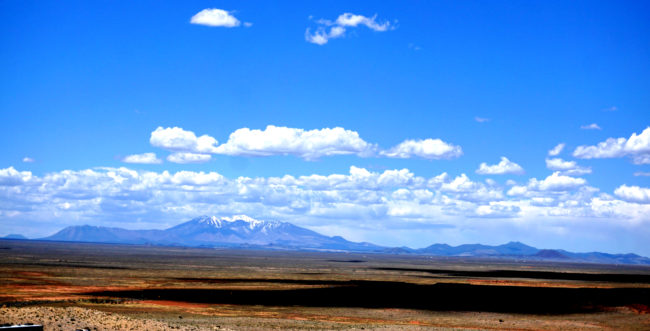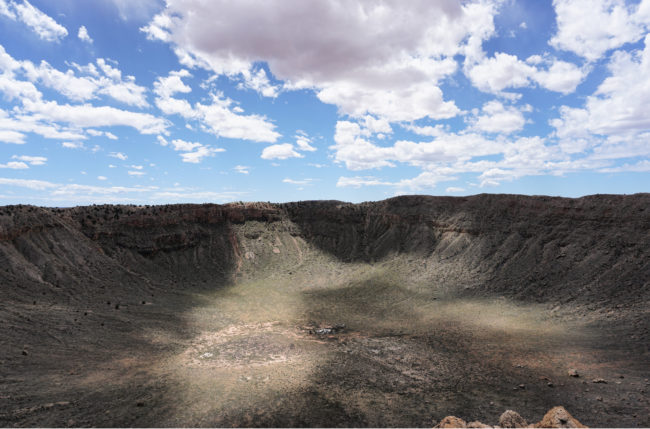Meteor Crater
by Jane St. Clair
I think I can. I think I can. Keep going. Be positive. Practice “The Secret” and all your dreams will come true.
Americans have been into positive thinking since our country began. We believe if you always keep going, you’ll always succeed.

This is just the thinking that got Daniel Barringer in trouble, and trouble on a colossal scale.
Born in 1860, Barringer was a whiz kid from a prominent family. He graduated from Princeton when he was only nineteen years old, and then earned degrees in law and geology. He went out West when he was in his early thirties, and invested in get-rich-quick schemes. Barringer got rich quick, making a fortune in gold and silver mining.
He was traveling in Arizona along what was then a broken-down road about 35 miles from Flagstaff. The landscape is very plain and vast, broken up only by Humphreys Peak miles and miles in the distance.
Our hero had heard about a huge crater formed by an ancient volcano. This great big bowl that pocks its lonely desolate landscape is stunning when you first see it. It’s in pristine condition as craters go, and gigantic, measuring a mile wide and 600 feet deep. You can fit 20 football fields and their stadiums in it.
For Daniel Barringer, it was love at first sight.
Barringer believed that it was the result of a gigantic meteor crashing to earth, not a volcano. His plan was to find the remains of the “dead meteor” that was buried there, and then make a billion dollars mining its minerals. Literally one billion dollars.
Barringer began digging holes in the crater in 1906. You can still see his mining equipment at the bottom of the meteor crater. He kept digging and digging, but the most he found were just big chunks of silvery rock.
He literally put his entire fortune into that hole –$600,000 or the equivalent of $7 million today. Nothing, not even the pleas of his wife and family who got sick of living in the middle of nowhere, could stop him. What must it be like to dig holes for 23 years in what you think is an impact crater, and what everyone else thinks is the remains of a volcano?
In the early 1920s, Barringer recalculated his mathematic formulas, and concluded that the meteor must have landed sideways at a 45 degree angle. He kept digging into the side of the meteor crater, still without any pay-off.
On October 29, 1929, the stock market crashed and wiped out what little remained of Barringer’s money. A month later Barringer died of a heart attack, believing he was a failure.
 Yet our story is not over yet. By the 1960s, astronomers were taking another look at the meteor crater and Barringer’s theory. The modern theory is that he was right all along – the crater was the result of a gigantic meteor about 160 feet across, traveling about 26,000 miles an hour, and crashing into the desert floor.
Yet our story is not over yet. By the 1960s, astronomers were taking another look at the meteor crater and Barringer’s theory. The modern theory is that he was right all along – the crater was the result of a gigantic meteor about 160 feet across, traveling about 26,000 miles an hour, and crashing into the desert floor. 
So it’s true, kids! This Thing Came From Outer Space!
What Barringer got wrong was that the meteor was traveling so fast and was so big that most of it blew apart and vaporized before it landed, which is why he only could find only fragments of it.
Barringer’s descendants still own and operate the meteor crater, now designated a National Natural Landmark. A popular tourist spot, it’s also where all American astronauts, including the ones who went to the moon, go for training.
including the ones who went to the moon, go for training.
The meteor crater still has the “Wow” factor –the feeling you get whenever you look at the stars, whenever you think of going boldly where no one has gone before, and whenever you believe in something no matter what anyone else believes.
Maybe that’s Barringer’s true legacy.
To plan your visit to Arizona’s meteor crater, visit their website here.
Jane St. Clair’s short story, “Hair Like Julia Roberts,” has been accepted for publication by Weber, Journal of the Contemporary West. The story is about a couple who tries to escape a religious desert cult.




